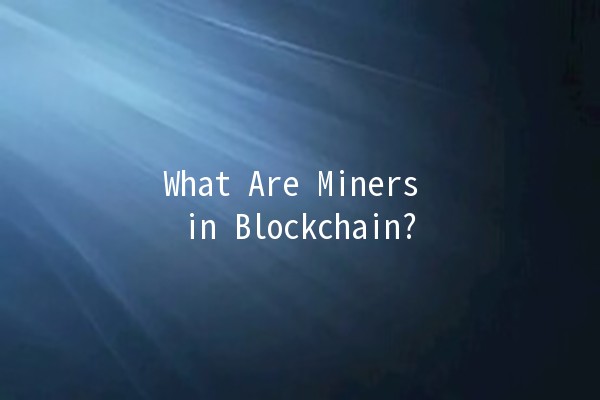
In the world of blockchain technology, the term "miner" holds significant importance. Miners play a crucial role in maintaining the integrity and security of blockchain networks. This article delves into the function of miners, their process, and the impact they have on cryptocurrency ecosystems. By the end, you'll gain valuable insights into how mining operates and why it is essential for blockchain networks.
Understanding Blockchain Technology

Before exploring what miners do, it is vital to understand the principles behind blockchain technology. Blockchain is a decentralized, digital ledger that records transactions across multiple computers in a secure and transparent manner. Each block within the chain contains a list of transactions, a timestamp, and a cryptographic hash of the previous block, making it nearly impossible to alter any of the data without consensus across the network.
Key Features of Blockchain:
What Are Miners?
In the context of blockchain, miners are individuals or entities that validate and record transactions on a blockchain. They utilize powerful computers to solve complex mathematical problems that allow them to add new blocks of transactions to the blockchain. The process of mining is integral to maintaining the network's integrity, as it prevents double spending and ensures that all transactions are legitimate.
The Mining Process
The mining process involves several key steps:
The Role of Miners in Blockchain Security
Miners serve as the backbone of blockchain security. Their work ensures that the blockchain remains trustworthy and incorruptible. A few critical functions related to miners and security include:
Miners verify each transaction before it is added to the blockchain. This process ensures that the same digital currency cannot be spent twice, maintaining the integrity of the financial system.
For a new transaction block to be added, the majority of miners must agree on its validity. This consensus mechanism prevents malicious actors from manipulating the blockchain.
The computational effort required for mining acts as a deterrent for attacks. To alter a transaction, a hacker would need to control a significant portion of the network's mining power, which is highly unlikely and prohibitively expensive.
The Economic Incentives for Miners
Mining is not just about maintaining the network; it is also an economic endeavor. Here are the key economic incentives for miners:
Tips for Aspiring Miners
If you are considering entering the world of mining, here are five tips to increase your productivity and improve your chance of success:
Not all cryptocurrencies are equally profitable to mine. Research various cryptocurrencies to identify those that provide favorable mining rewards compared to energy consumption and hardware costs.
Example: Bitcoin mining requires specialized ASIC hardware and consumes a lot of energy. However, alternative coins like Monero or Ethereum (prior to its transition to Proof of Stake) may be more accessible with standard PCs or GPUs.
The type of mining hardware significantly affects efficiency and profitability. Invest in highperformance mining rigs optimized for your chosen cryptocurrency.
Example: For Bitcoin, considered ASIC miners like the Antminer S19, which offer higher hashing power than traditional GPUs.
Mining on your own can be challenging due to the high competition in the market. Joining a mining pool allows miners to combine their resources and share rewards, increasing chances of consistent payouts.
Example: Pools like Slush Pool or F2Pool can provide steady income, even if it might be smaller due to shared rewards.
Mining consumes a substantial amount of energy. Track your electricity usage and seek competitive rates, as high energy costs can erode profit margins.
Example: Some miners relocate to areas with lower electricity rates, such as certain regions in Canada, to maximize their profits.
The cryptocurrency market is highly volatile and constantly evolving. Stay informed about network updates, changes in mining difficulty, and trends in cryptocurrency prices to adapt your strategy.
Example: Changes in mining algorithms can impact profitability, such as Ethereum’s transition to Proof of Stake, which may encourage miners to shift to other coins.
Common Questions About Mining in Blockchain
Mining involves solving complex mathematical problems to validate transactions and secure the blockchain, while staking involves locking a certain amount of cryptocurrency to support network operations and validate transactions. Staking usually requires less computational power and is more energyefficient.
Yes, anyone can become a miner. However, the level of competition, the initial investment in hardware, and the understanding of technology required can be significant barriers for new miners.
A 51% attack occurs when a single miner or group of miners gains control of more than 50% of the network's mining power. This control allows them to manipulate the blockchain, such as reversing transactions. It's an extremely rare scenario due to the vast resources needed.
Profitability depends on various factors, including the cryptocurrency being mined, the cost of electricity, and the current market value of the coin. It is advisable to calculate potential returns against expenses using mining profitability calculators available online.
Mining pools are groups of miners who work together to increase their chances of earning rewards. They combine their computational power, and when the pool successfully mines a block, the rewards are distributed among the participants based on their contribution.
Yes, mining can lead to significant energy consumption, raising concerns about its environmental impact. Many miners are exploring renewable energy sources to mitigate this issue and reduce their carbon footprint.
Miners are a vital component of blockchain networks, ensuring transaction validity and maintaining the system's integrity. Understanding how mining works can provide invaluable insights for individuals interested in entering the cryptocurrency space. By considering the tips and information outlined in this article, aspiring miners can enhance their chances of success in this exciting and everevolving field.

